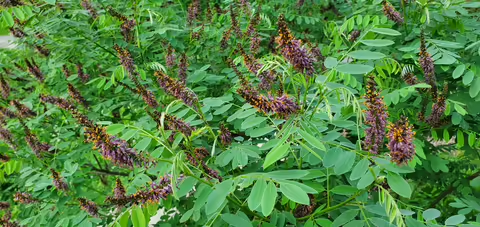Native plants are ever gaining popularity as gardeners seek specimens with high ecological value in support of declining insect pollinator populations. Among the almost 2,300 plant species known to be native in Illinois, our native shrubs are often overlooked and underappreciated in the landscape. However, many offer a wide variety of ornamental attributes along with high pollinator value.
Indigo bush (Amorpha fruticosa), also known as false indigo, is a native shrub that typically occurs in habitat associated with river systems. It frequents riverbanks and other bottomland locations with more open tree canopy and partial sun, along with woodland edges and prairie habitats that occur near streams. As with many other plants that occur along stream systems, it is adapted to a wide range of conditions and can tolerate very wet soils, including occasional flooding.
This adaptability to soggy soil translates into excellent tolerance for urban soil conditions which are often compacted and lower quality than naturally occurring soils. Since indigo bush can easily handle the low oxygen associated with flooded soils, it adapts well to compacted soils which are also low in oxygen. As an added bonus, this plant is a nitrogen fixer, meaning it has the ability to release nitrogen into the soil through a symbiotic relationship with soil bacteria.
The flowers on this plant are exceptional and fill the shrub canopy with purple to indigo colored spikes that can reach up to 6 inches long. The contrasting yellow anthers, which are the flower parts containing pollen, create a showy display for several weeks around this time of year.
Plants in my yard have just about finished blooming for the season and have been a flurry of pollinator activity for the past few weeks. As each flower structure develops on the branch tips, sometimes in groups of up to 4 individual spikes, new florets mature slowly to produce a continuous supply of nectar and pollen for up to about 3 weeks. I always enjoy watching the contrasting purple and yellow color move from the base of each flower structure to tips over its bloom time.
Foliage on this plant is an attractive light green, consisting of fine textured, compound leaves with tiny leaflets around one inch in length. It casts a diffuse shade, much like honey locust, which allows plenty of light for smaller plants to thrive below.
Indigo bush matures to large spreading shrub, sometimes reaching up to 15 ft in full sun. It is also thicket forming since it spreads by new shoots, which limits its application as a specimen plant. However, in the right location with some room to spread, it’s creates a wonderful natural screen or hedge-type planting. Size and spread can be limited with selective pruning or rejuvenation pruning (removing all stems at ground level). This plant flowers on new wood, so pruning should be done in late winter or early spring, prior to bud break.
For a smaller version of this plant, with comparable attractive, fine-textured foliage and very similar purple-yellow flowers, consider adding leadplant (Amorpha canescens) to your landscape. It matures to rounded shrub, about 4-5ft tall and a bit wider than it is tall. Leadplant flowers a little later in the year but offers an equally long bloom time of about 3 weeks and a ton of pollinator attraction.
I actually had leadplant in mind when I purchased the Indigo bush that now happily resides in our front yard. I read “Amorpha” on the plant tag, but the species didn’t register as my memory must be a bit fuzzy on that distinction. Both plants have multiple common names, so I certainly had disregarded that detail. Nonetheless, I was thrilled to see that my “leadplant” put on ample growth in its first season, thinking that I must have just sited this plant perfectly and praising myself for such great gardening ability.
Now the plant is in its 3rd year of growth and it is just exploding out of the planting location. This year, its awesome size and earlier blooms than expected called into question my species selection. As I went back to review the plant tag and refreshed my Latin, I realized that this shrub was certainly a case of mistaken identity. I had indeed planted A. fruticosa thinking it was A. canescens.
As gardeners, I think we all love to experiment, so I’ll chalk this blunder up to experimentation. I look forward to seeing if my plant can peacefully coexist with others in its limited space. A rejuvenation pruning is certainly on the docket for next spring!
